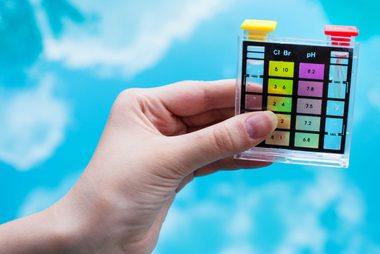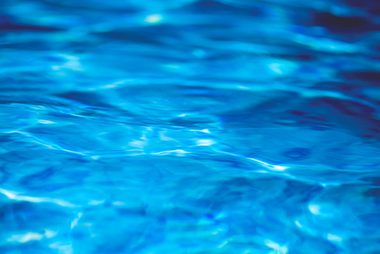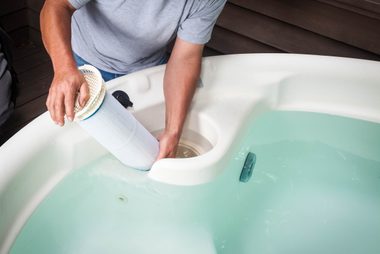
Hot tubs are very, very cozy
Swimming in any body of water exposes you to skin cells, urine, and other contaminants. Pools have a large amount of water to disperse them, but hot tubs hold less water. “You’re bathing in close quarters with however many of your friends are with you,” says Kelly Reynolds, PhD, microbiologist and associate professor in the public health college of the University of Arizona. With less water to dilute any contaminants, the concentration is higher in a hot tub.

It’s hard to keep chlorine levels up to snuff
Those tight quarters also make it tough to keep up with a hot tub’s chlorine demands. Chlorine sticks to skin cells, sunscreen, and body oils, meaning you’re taking some out with you when you’re done soaking. Every time you hop in and out, you mess with the levels even more. “When you get out of a hot tub or swimming pool and smell chlorine on your skin, you’ve taken some of that chlorine with you,” says Dr. Reynolds. “You’re just increasing the chlorine demand by going in and out and bringing debris into the hot tub.” Public hot tubs usually get checked multiple times per day, but you probably aren’t as diligent with your private one. Dr. Reynolds recommends testing the levels more often, and showering before hopping in the hot tub to rinse off any oils. Find out the healthiest shower temperature.

Bacteria keep growing at night
“If you’ve used the hot tub during the day, you introduced bacteria to the hot tub,” says Dr. Reynolds. “You don’t want time for those bacteria to grow overnight.” She recommends shocking the water with an extra-high amount of chlorine before you head in for the night. The next day, test the water again to make sure chlorine levels are safe before you use it again. Meanwhile, learn how to clean your bathing suit without ruining it.

Poop makes its way in
“Depending on how effective you are at wiping or bathing before you swim, all of us carry some residual amounts of feces,” says Dr. Reynolds. “When you jump in the pool, that gets released into the water.” The bacteria in that poop could cause stomach infections—luckily, they can only infect via the mouth, and most people don’t stick their faces underwater in hot tubs. But be extra careful if you’ve had diarrhea recently. You could still be carrying those germs up to two weeks after your symptoms are gone. Learn what your bowel movements reveal about your health.

Chlorine won’t kill all bacteria
Cryptosporidium and Giardia are parasites that can cause you to have diarrhea for weeks—and both are resistant to chlorine. “Most people don’t know you really shouldn’t swim with other people” when infected, says Dr. Reynolds. She recommends shock-chlorinating a hot tub so the high levels can kill off the parasites, or waiting until the filtration process finishes.

Hot tub rash is pretty common
One type of bacteria that particularly likes warm water is Pseudomonas. With an infection, you could end up with a rash called hot tub folliculitis. “Everywhere you have a hair follicle, you could get a welt or a boil,” says Dr. Reynolds. Some people might get just one or two welts, but others could be covered head to toe. It’s hard to treat, and even though it will go away on its own after a few weeks, the rash could leave you with scars for about a year. Try these home remedies for rashes.

You could get a respiratory infection
Legionnaire’s disease is a rare, severe form of pneumonia caused by Legionella bacteria that live naturally in water. The bacteria particularly love warm, spraying environments like home water heaters, shower aerosol mists—and hot tubs. As you soak, you could be breathing in the bacteria. “You get these little aerosol mists at the surface that you’re breathing in,” says Dr. Reynolds. “It creates that route of transmission.”

You could get a staph infection
About a third of the population carries the bacteria Staphylococcus aureus (staph), according to the CDC. In a hot tub, any open wound—even ones you didn’t know you had—could let staph into your body. “Small knicks from shaving could create an entry point,” says Reynolds. From there you could get a skin infection similar to hot tub rash. Even worse, a less common form of staph called MRSA is resistant to antibiotics, making the painful bumps even harder to treat. Don’t miss these signs your cut is infected.